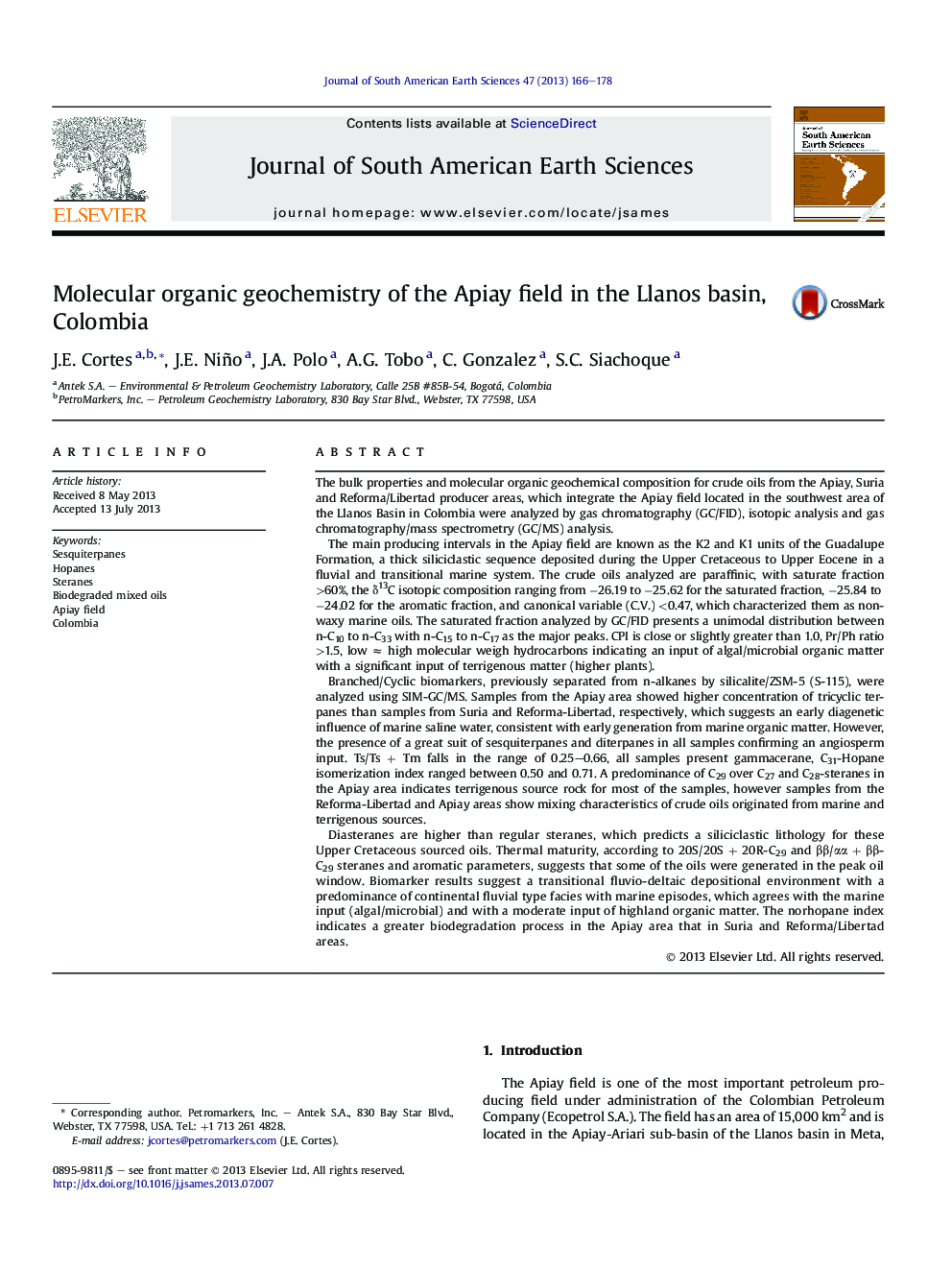| کد مقاله | کد نشریه | سال انتشار | مقاله انگلیسی | نسخه تمام متن |
|---|---|---|---|---|
| 6431443 | 1635162 | 2013 | 13 صفحه PDF | دانلود رایگان |

- The bulk properties in Apiay field crude oils are studied.
- Crude oils have marine and terrestrial sources.
- Biomarker composition suggests a transitional fluvio-deltaic environment.
- Depositional conditions indicate continental and marine facies.
- Mixed crude oils with severe biodegradation process are present in Apiay field.
The bulk properties and molecular organic geochemical composition for crude oils from the Apiay, Suria and Reforma/Libertad producer areas, which integrate the Apiay field located in the southwest area of the Llanos Basin in Colombia were analyzed by gas chromatography (GC/FID), isotopic analysis and gas chromatography/mass spectrometry (GC/MS) analysis.The main producing intervals in the Apiay field are known as the K2 and K1 units of the Guadalupe Formation, a thick siliciclastic sequence deposited during the Upper Cretaceous to Upper Eocene in a fluvial and transitional marine system. The crude oils analyzed are paraffinic, with saturate fraction >60%, the δ13C isotopic composition ranging from â26.19 to â25.62 for the saturated fraction, â25.84 to â24.02 for the aromatic fraction, and canonical variable (C.V.) <0.47, which characterized them as non-waxy marine oils. The saturated fraction analyzed by GC/FID presents a unimodal distribution between n-C10 to n-C33 with n-C15 to n-C17 as the major peaks. CPI is close or slightly greater than 1.0, Pr/Ph ratio >1.5, low â high molecular weigh hydrocarbons indicating an input of algal/microbial organic matter with a significant input of terrigenous matter (higher plants).Branched/Cyclic biomarkers, previously separated from n-alkanes by silicalite/ZSM-5 (S-115), were analyzed using SIM-GC/MS. Samples from the Apiay area showed higher concentration of tricyclic terpanes than samples from Suria and Reforma-Libertad, respectively, which suggests an early diagenetic influence of marine saline water, consistent with early generation from marine organic matter. However, the presence of a great suit of sesquiterpanes and diterpanes in all samples confirming an angiosperm input. Ts/Ts + Tm falls in the range of 0.25-0.66, all samples present gammacerane, C31-Hopane isomerization index ranged between 0.50 and 0.71. A predominance of C29 over C27 and C28-steranes in the Apiay area indicates terrigenous source rock for most of the samples, however samples from the Reforma-Libertad and Apiay areas show mixing characteristics of crude oils originated from marine and terrigenous sources.Diasteranes are higher than regular steranes, which predicts a siliciclastic lithology for these Upper Cretaceous sourced oils. Thermal maturity, according to 20S/20S + 20R-C29 and ββ/αα + ββ-C29 steranes and aromatic parameters, suggests that some of the oils were generated in the peak oil window. Biomarker results suggest a transitional fluvio-deltaic depositional environment with a predominance of continental fluvial type facies with marine episodes, which agrees with the marine input (algal/microbial) and with a moderate input of highland organic matter. The norhopane index indicates a greater biodegradation process in the Apiay area that in Suria and Reforma/Libertad areas.
Journal: Journal of South American Earth Sciences - Volume 47, November 2013, Pages 166-178